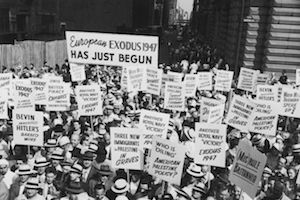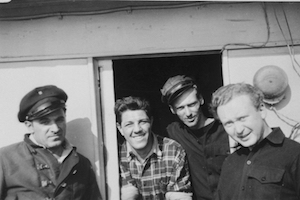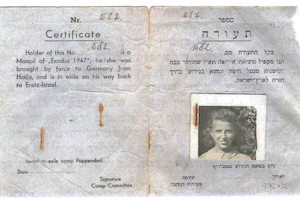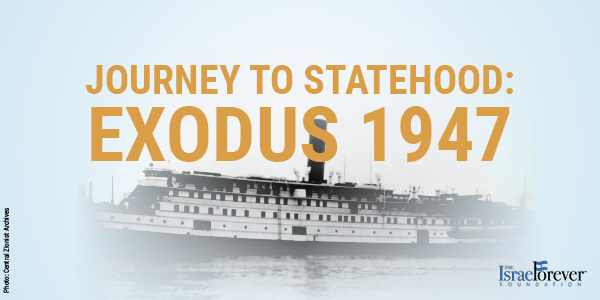Exodus 1947: History in the Making
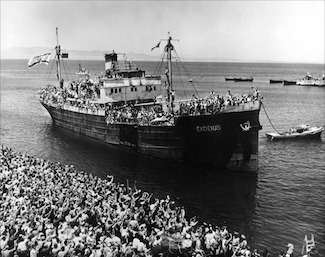
The Exodus 1947 that carried Jewish emigrants from France to British Mandatory Palestine in July 1947.
The war with Germany was over, but for thousands of Holocaust survivors, the fight for survival was far from won.
Walking out of the ruins of Europe, displaced from their homes often with no family, possessions or anywhere to return, these survivors looked toward Israel as a place to call home. But getting there was a battle that few saw coming.
The day was July 9, 1947. Off the coast of France between Marseilles and the Spanish border, 4515 men, women and children - most of whom Holocaust survivors - who had travelled the land route from Poland and Germany, across France to the Mediterranean were gathered together, awaiting the fulfillment of a dream. Orthodox, traditional and secular, moderates and socialists, the gentle and the fire-brands. All night they moved on 70 trucks transferring human cargo to the port, showing their fake Colombian passports to sleepy-eyed French customs agents. On the morning of July 11, 1947, the President Warfield 1947 set sail from Sète, France.
A one-time pleasure cruiser, later used by the allies to transport supplies during the Normandy invasion, the vessel had set sail from Baltimore, where American Jews had purchased it for $40,000. The dilapidated ship made its way to Italy, where it was gutted and refurbished so that it could hold as many passengers as possible (it was originally designed for around 400).
Under the leadership of members of the Haganah, the Jewish Agency for Israel, and 35 American volunteers, including several Christian Zionist supporters, boarded the ship that would come to be known as the Exodus that made its way to the shores of freedom in the Land of Israel.
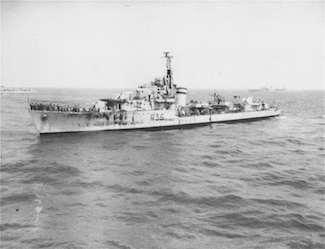
Two British warships were dispatched to prevent the landing of the Exodus 1947 off the coast of Palestine.
Having been spotted by a British observation plane, the British called the French and the ship was under orders not to sail. American volunteer Bernie Marks snuck into the water, and swam to the pier to loosen the ropes. The engines pounded and she started to move. With no lights showing and without the aid of a pilot or tug, the Captain Ike Aharanovitz steered his ship out of the harbour into the Mediterranean under the cover of darkness. She had to maneuver 120 degrees in a port made for ships one tenth her size. After getting stuck in the mud, using all her horsepower, the Warfield finally managed to pull free.
Almost immediately after disembarking, the ship was followed by a British armada fleet that grow, upon arrival to the coast of Haifa, to 12 ships, including 3 destroyers and a cruiser, determined to stop the journey towards Palestine and, inevitably, crush the dreams of the survivors of the Holocaust who coped with problems of cleanliness, shortage of food, and an inability to bear the incredible weight of nearly 100 times the anticipated cargo for this ship. Any sudden shift of a hundred people could literally capsize the ship. HaShomer HaTzair members were assigned the duty of policing the crowd. Water was rationed. Even the passengers had jobs: helping in the commissary, cleaning the ship, teaching Hebrew and producing a handwritten newsletter.
Of the refugees on board, most had known death in concentration camps. Some had joined the partisans. Some had the tattoos from Dachau and Buchenwald, and some still wore the yellow star armband, but now with pride.

Jewish refugees look out the window of The Exodus on July 22, 1947
On Wednesday, July 16th, a woman died in childbirth. Her new-born son lived. In an evening ceremony, the body, wrapped in a handwoven flag of Zion, was lowered into the sea, accompanied by Hebrew prayers. The journey had claimed its first martyr.
After 6 days at sea in treacherous conditions, on July 17, 1947, the British took action to “stop Warfield at all costs”. Under the British Mandate for Palestine, and with the White Paper of 1939 in effect, the British resisted the clandestine immigration efforts with fanatical determination. This small ship could not be allowed to best the might of His Majesty’s Royal Navy. A mere 10 kilometers off the coast of Palestine, while still in international waters, the British command delivered a warning: "You are suspected of trying to enter to Palestine with illegal immigrants. It is forbidden. Please do not resist. We have superior forces here and in Palestine. If it becomes necessary, we will use force to board, but you will have medical attention."
A message was sent back to the British saying that there were over 4500 Jews on board who would not go back to concentration camps, even British ones.
In an unimaginable display of aggression, two British destroyers rammed the ship from both sides, damaging the hull, railings and lifeboats. As British marines began to board, the Zionist blue-white flag with the Star of David was raised and the wooden planks carrying the name President Warfield were flipped over to reveal the ship’s new name, Haganah Ship – Exodus 1947, and “Hatikvah” was sung over and over.
The refugees used tin cans, screwdrivers, potatoes, bottles, wooden boards and metal bars as weapons.
The British used tear gas and pistols, and the uneven battle raged for more than 2 hours. An American Jewish crew member and two passengers were killed. Dozens suffered bullet wounds and other injuries.
The Jews simply wanted to go home.
After the fierce and unexpected battle, a taut voice was heard broadcasting in a fine American accent to all of Palestine on Kol Yisrael (the Voice of Israel), the Haganah secret radio:
"This is the refugee ship, Exodus 1947. Before dawn today we were attacked by five British destroyers and one cruiser at a distance of 17miles from the shores of Palestine, in international waters. The assailants immediately opened fire, threw gas bombs, and rammed our ship from three directions. On our deck there are one dead, five dying, and 120 wounded. The resistance continued for more than 3hours. Owing to the severe losses and the condition of the ship, which is in danger of sinking, we were compelled to sail in the direction of Haifa in order to save the 4500 refugees on board from drowning."
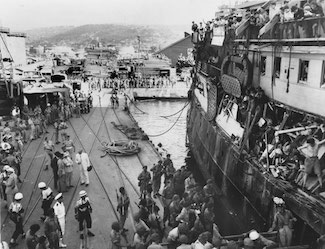
The Exodus 1947 arrived at the Haifa Port on July 18th.
On July 18, 1947 at 4:00 p.m., on the eve of the Jewish Sabbath, the Exodus was towed into Haifa harbor. The journey of the Exodus was over but not that of the refugees. Amid worldwide public outrage, the British compelled the passengers to disembark and some were forcibly removed to be registered and then reloaded onto ships that they said would be sent to Cyprus. But the deception of the British and the plight of these Jews did not end.
Slowly, surrounded by armed British soldiers, they made their way off the ship, the infirm, the elderly, pregnant women, children, frightened, disoriented, disheartened. Herded into stockades, they were callously sprayed with a delousing agent and after barely touching land, transferred to three navy transports converted to caged prison ships. The loading completed, the ships headed out to sea. The next day, the ships departed Haifa with the "Exodus" passengers, sailing back toward the European mainland, back toward France.
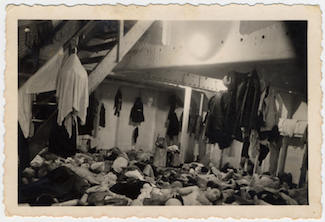
Crowded sleeping quarters aboard The Exodus 1947. © US Holocaust Memorial Museum, courtesy of Giza Wiernik
The conditions on board these ships were beyond imagination. The refugees lay crammed together in the bare holds of the freighters. Exhausted, weak, sick and yet unwilling to give up hope, the passengers of the Exodus refused to disembark upon their arrival in Toulon, France. Even the French authorities refused to remove the passengers by force, and the British authorities, fearing rising adverse public opinion, finally agreed to wait until the passengers left of their own accord. The passengers, including many orphaned children, declared a hunger strike which lasted 24 days.
With French authorities unwilling to take part in the forced evacuation of the Jews, the British returned them to Hamburg in the British-occupied zone of Germany where they were housed in displaced persons camps and, some, in former concentration and labor camps. The agony, the nightmares, the crushed hopes were too much to bear but the outpouring of support from communities and organizations worldwide were an affirmation that the plight of the Exodus refugees were not forgotten, nor in vain.
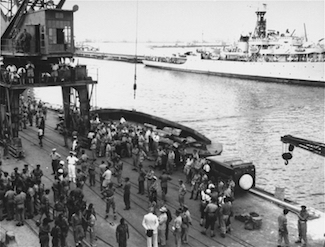
British soldiers transfer Jewish refugees from The Exodus 1947 to the deportation ships.
The British created a shock by announcing that they would have a "selection" to make sure that the Jews were indeed survivors, and not "plants" by the Haganah. When the ships came to the dock, some Jews left peacefully. Most were dragged from the ships by 2500 British marines, using their clubs liberally. At the Poppendorf and Amstau DP Camps, every Jew gave his name as one from the Bible, and all responded to the question of ancestry or country of birth, with the word "Palestine", without exception. The Haganah had given each of the 4500 refugees a stamped certificate with the promise that they would one day see Palestine. It was sealed with the seal of the Palmach - the olive branch and the sword.
Global outrage turned toward the British, for their unimaginable cruelty. International campaigns and media attention aroused support for the Jewish nationalist dream that swayed the opinion of policy makers set to vote on the partition of Palestine for the creation of a Jewish state and an Arab state side by side on November 29, 1947.
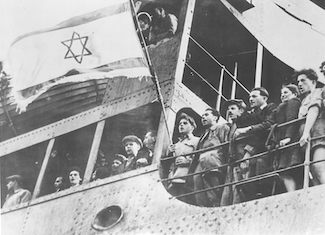
The plight of the Exodus passengers, and the cruel inhumane treatment they received, aroused worldwide support for the Zionist cause and became a symbol for many of the need for Jews to govern themselves in their own homeland of Israel.
In all 68 ships participated in rescue efforts during the British Mandate. Many voyages, like that of the Exodus, failed; However during the Mandate over 60,000 illegal immigrants were successfully transported to Palestine. Most were present in Israel on May 15, 1948 when the nation declared its independence.
On September 7, 1948, a telegram from the vicinity of Poppendorf reached Mossad headquarters in Paris. It was dramatically simple: "We have sent off the last of the Exodus passengers from Germany...We have kept our promise." Finally in January of 1949, when Great Britain recognized the State of Israel, the detainees in Cyprus and all other remaining surviving passengers made aliyah.
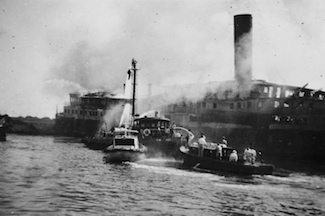
Fireboats try to put out a fire on the Exodus 1947 ship in Haifa harbor.
Originally intended to be turned into a floating museum, the Exodus caught fire in 1952 and was towed out of the shipping area where she sank, an ignoble end to a noble ship. Today, there is a new memorial established just across the very spot from where the Exodus stood, filled with the hopes and dreams of millions of Jews who never benefitted to live free in our homeland. Today, we can all take part in remembering and in inheriting the legacy of this journey towards statehood.
Recommended for you:
JOURNEY TO STATEHOOD: EXODUS 1947
Learn more about The Exodus 1947 today!
About the Author



